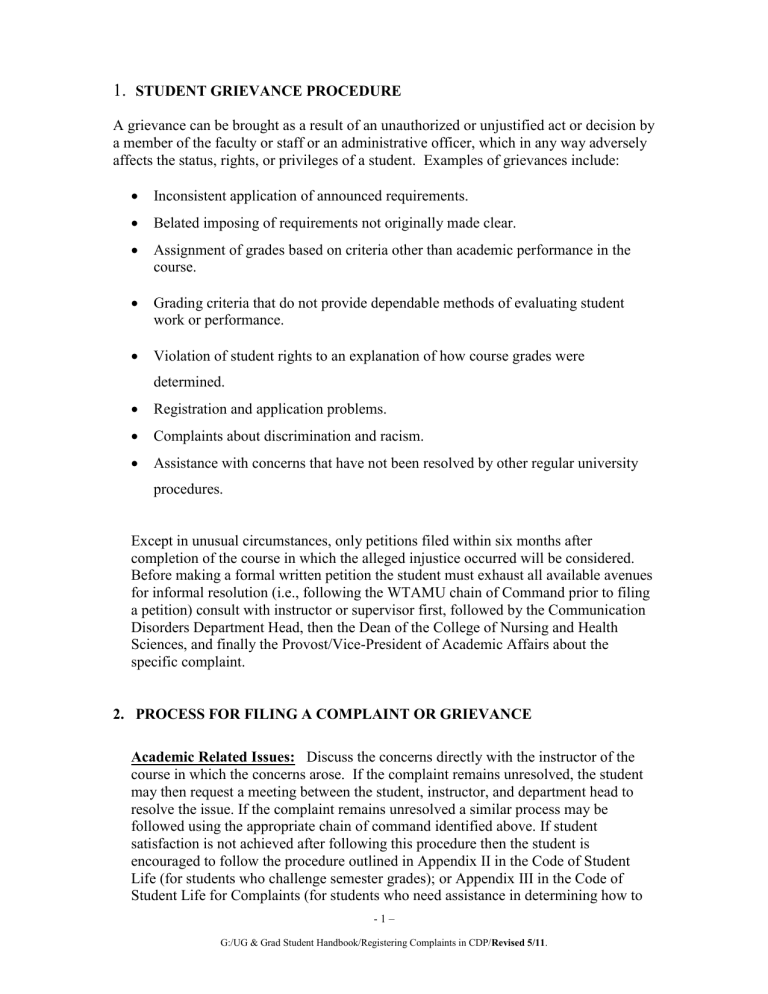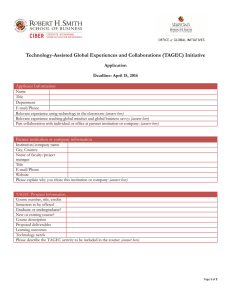Grievance Procedures

1.
STUDENT GRIEVANCE PROCEDURE
A grievance can be brought as a result of an unauthorized or unjustified act or decision by a member of the faculty or staff or an administrative officer, which in any way adversely affects the status, rights, or privileges of a student. Examples of grievances include:
Inconsistent application of announced requirements.
Belated imposing of requirements not originally made clear.
Assignment of grades based on criteria other than academic performance in the course.
Grading criteria that do not provide dependable methods of evaluating student work or performance.
Violation of student rights to an explanation of how course grades were determined.
Registration and application problems.
Complaints about discrimination and racism.
Assistance with concerns that have not been resolved by other regular university procedures.
Except in unusual circumstances, only petitions filed within six months after completion of the course in which the alleged injustice occurred will be considered.
Before making a formal written petition the student must exhaust all available avenues for informal resolution (i.e., following the WTAMU chain of Command prior to filing a petition) consult with instructor or supervisor first, followed by the Communication
Disorders Department Head, then the Dean of the College of Nursing and Health
Sciences, and finally the Provost/Vice-President of Academic Affairs about the specific complaint.
2.
PROCESS FOR FILING A COMPLAINT OR GRIEVANCE
Academic Related Issues: Discuss the concerns directly with the instructor of the course in which the concerns arose. If the complaint remains unresolved, the student may then request a meeting between the student, instructor, and department head to resolve the issue. If the complaint remains unresolved a similar process may be followed using the appropriate chain of command identified above. If student satisfaction is not achieved after following this procedure then the student is encouraged to follow the procedure outlined in Appendix II in the Code of Student
Life (for students who challenge semester grades); or Appendix III in the Code of
Student Life for Complaints (for students who need assistance in determining how to
- 1 –
G:/UG & Grad Student Handbook/Registering Complaints in CDP/ Revised 5/11 .
proceed with a complaint); or Appendix IV in the Code of Student Life (for students whose grievances are not related to semester grades).
Clinically Related Issues: Discuss the concerns directly with the clinical supervisor of the practicum site in which the concerns arose. If the complaint remains unresolved, the student may then request a meeting between the student, clinical supervisor, and clinical coordinator to resolve the issue. If the complaint remains unresolved a similar process may be followed using the appropriate chain of command identified above. If student satisfaction is not achieved after following this procedure then the student is encouraged to follow the procedure outlined in Appendix II in the
Code of Student Life (for students who challenge semester grades); or Appendix III in the Code of Student Life for Complaints (for students who need assistance in determining how to proceed with a complaint); or Appendix IV in the Code of Student
Life (for students whose grievances are not related to semester grades).
Students may file a complaint with the Council on Academic Accreditation (CAA) by writing to:
Council on Academic Accreditation
ASHA
10801 Rockville Pike
Rockville, Maryland 20852-3279
Or by calling: (301) 897-5700
Relevant Section from New CDP Undergraduate and Graduate Student Handbook
Relative to Complaint Process Specifically Addressing Clinical Externship Practicum complaints.
GUIDELINES FOR HANDLING CONFLICTS
Conflicts may arise of for a variety of reasons including differing expectations between supervisor/instructor and student, lack of communication, misunderstanding of procedure, etc. The following guidelines were authored by Mediate.com and serve and important steps for constructively mediating conflict:
1. Ask yourself what it is you don't know yet.
Keep in mind that you don't know what story is foremost in other people's minds. Each individual has his or her own story about what is important and why. Insight into these different stories can make a great difference for how you and other people handle the conflict. Take on conflict situations with an intention to understand more about what is going on. Ask open-ended questions, questions that help you to understand the background of the conflict better. People's images of what is significant in specific situations are important reasons for their actions.
- 2 –
G:/UG & Grad Student Handbook/Registering Complaints in CDP/ Revised 5/11 .
These images can change, thereby changing the parties' attitudes and actions. Remember also to remain open to learning new things about yourself and how other people perceive you. Maybe other parties feel that you have contributed more to the problems than you are aware of.
2. Make a distinction between the problem and the person.
Formulate the conflict issues as shared problems that you have to solve cooperatively. Abstain from blaming and voicing negative opinions about others. State clearly what you feel and want and invite your counterpart to help in finding solutions. Opinions and emotions should be expressed in ways that facilitate the process of achieving satisfying outcomes. Keep in mind that there is always some kind of positive intention behind people's actions, even if unskillfully expressed.
3. Be clear, straightforward and concrete in your communication.
State clearly what you have seen, heard and experienced that influenced your views in the matter at hand.
Tell the other person what is important to you, why you find it important, what you feel and what you hope for. Express your own emotions and frustrated needs in clear and concrete words. Ask for the counterpart's fears and needs in a way that conveys that you care about them.
4. Maintain the contact with your counterpart.
Breaking off the contact with the counterpart in a conflict often leads to a rapid conflict escalation. Do what you can to keep the communication going. Work to improve your relationship even if there are conflict issues that seem impossible to resolve. Offer to do something small that meets one of your counterpart's wishes and suggest small things your counterpart can do to meet your own needs and wishes. Even if marginal, such acts can strenghten the hope that it will be possible to change the nature of the relationship in a positive direction.
5. Look for the needs and interests that lie behind concrete positions.
Bargaining about positions often leads to stalemates or unsatisfying solutions. Inquire into what needs and interests would be satisfied by certain concrete demands and explore if there are alternative and mutually acceptable ways of satisfying those needs and interests.
Regard blaming, accusations and negative opinions as unskillful ways of expressing emotions. Show understanding for the feelings of the other party without letting yourself be provoked by their attacks. Inquire into what is really important and significant for yourself and keep those values and needs in mind during the course of the conflict.
6. Make it easy for your counterpart to be constructive.
Avoid triggering the defensiveness of your counterpart by blaming, accusing, criticizing and diagnosing.
Extend appreciation and respect for the counterpart where you can do so sincerely. Show your counterpart that you care about the issues and needs that are important to him or her.
Take responsibility for your own contributions to the conflict events.
7. Develop your ability to look at the conflict from the outside.
Review the conflict history in its entirety. Notice what kinds of actions influence the tensions of the conflict in positive and negative directions. Take care to develop your awareness of how you can influence the further course of events in the conflict in a constructive direction. Test your own image of what is going on by talking with impartial persons. Assume responsibility
- 3 –
G:/UG & Grad Student Handbook/Registering Complaints in CDP/ Revised 5/11 .
for what happens. Take on problems you see as early as possible, before they have a chance to develop into major conflict issues.
- 4 –
G:/UG & Grad Student Handbook/Registering Complaints in CDP/ Revised 5/11 .
